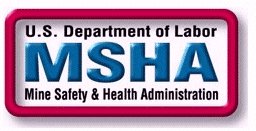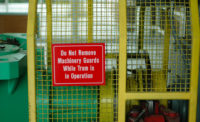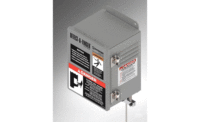 The Mine Safety and Health Administration (MSHA) has introduced a new compliance assistance resource intended to address one of the most commonly cited violations in the metal and nonmetal mining industry: improperly guarded machinery.
The Mine Safety and Health Administration (MSHA) has introduced a new compliance assistance resource intended to address one of the most commonly cited violations in the metal and nonmetal mining industry: improperly guarded machinery.
“Guarding Machinery at Metal & Nonmetal Mines” is a sequel to a compliance guide for guarding conveyor belts published in 2010. In that year, guarding-related violations peaked at 10,877 and accounted for one of every seven violations cited.
“The purpose of this new guide designed to improve mine safety is threefold: to improve the mining industry’s understanding of good guarding principles; ensure the construction, installation and maintenance of highquality, effective guards; and improve compliance, inspection and enforcement consistency,” said Assistant Secretary of Labor for Mine Safety and Health Joseph A. Main.
According to Parts 56/57.14107 of 30 Code of Federal Regulations, moving machine parts must be guarded to protect individuals from contacting gears; sprockets; chains; drive, head, tail and take-up pulleys; flywheels; couplings; shafts; fan blades; and similar moving parts that can cause injury. Guards are not required when the exposed moving parts are at least 7 feet away from walking or working surfaces.
Injuries related to equipment guarding typically occur because guards are missing, inadequately sized or positioned, and also may be due to miners handling or dropping heavy, unwieldy and other poorly designed, constructed or maintained guards. For example, in some cases, lacerations or other injuries may occur due to a guard’s construction.
The most recent mining fatality that involved improper guarding practices occurred in August 2011 at 4 J’s Gravel Crushing Plant 2 in Renville County, Minn. A 24-year-old equipment operator was killed when he became entangled in a feed belt conveyor’s head pulley components. MSHA determined that mine management failed to ensure that moving machine parts were guarded to protect miners from coming into contact with them.
The MSHA says the new guide, which is available at www.msha.gov, has been widely reviewed by industry stakeholders, MSHA inspectors and MSHA supervisors. It provides examples of good guarding practice and compliance information relating to all types of mining equipment, including drive and power transmission components; crushers and screens; rotating, packaging and palletizing equipment; power tools and auxiliary equipment.
The conveyor belt guarding guide was well received by the mining industry and has resulted in increased compliance and more consistent enforcement. Guarding-related citations and orders issued through the third quarter of fiscal year 2012 are down 39 percent from 2010 levels. Both guides have the same format: a photo-illustrated PowerPoint presentation with detailed explanatory notes.
“Both are valuable guarding compliance resources for miners, mine operators, miners’ representatives, independent contractors, equipment manufacturers and MSHA enforcement personnel,” said Main.


